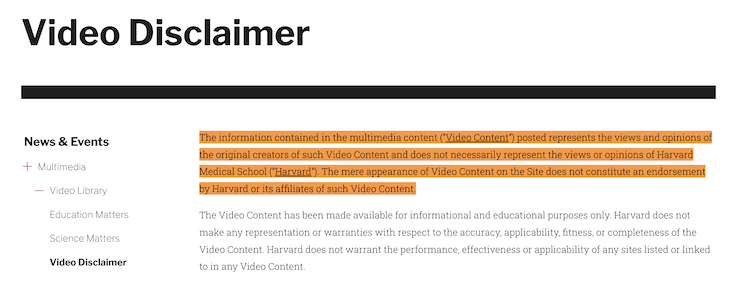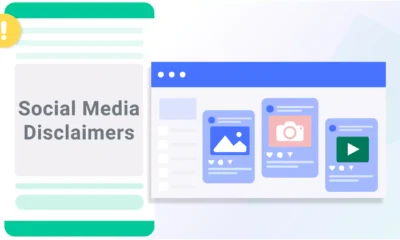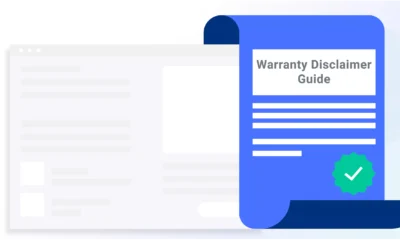A views expressed disclaimer is an essential disclaimer that informs readers that the opinions and thoughts expressed on a platform reflect only the author’s views and not the business itself.
Below, I explain when you need a views expressed disclaimer, describe when to use them and how to make your own, and show some real world examples.
How Can You Make a Views Expressed Disclaimer?
To make a views expressed disclaimer, use a generator or a template, or write one yourself.
Generate a Free Customized Disclaimer Using Termly
Here’s how to use Termly’s generator to create a custom and legally compliant disclaimer for your needs.
Step 1: Go to Termly’s disclaimer generator.
Step 2: Answer a few simple prompts and questions, and go through all the steps until you reach “Final Details.”

Step 3: Once you’ve filled in everything and are satisfied with the preview, click “Publish.”
You will then be prompted to create an account on Termly to save and edit your legal disclaimer further.
Template
You can make a views express disclaimer by modifying our free disclaimer template,
Fill in the blank sections with information about your website, remove any unnecessary details, and include the relevant information to disclaim that the opinions on your site only represent those of the original author.
You can then choose how to download and post it to your site.
Write Your Own Disclaimer
You can write a views expressed disclaimer for your company by following these steps:
- Clearly state that the views expressed in the content belong to the content creators and not the organization, its affiliates, or employees.
- Create a 1-2 sentence opinion disclaimer to include in guest/opinion content.
- Provide a link to your detailed disclaimer page.
Most companies that allow guest content have a separate page for disclaimers, which often include more than just their views expressed disclaimer.
However, a simple one-line statement such as “views expressed are my own” should be sufficient for individuals, especially for social media posts and profiles.
What Is a Views Expressed Disclaimer?
A views expressed disclaimer, also known as an opinion disclaimer, explains that the opinions expressed in any content are solely the author’s and don’t reflect the opinions or beliefs of the website and its affiliates.
You’ve probably seen many opinion disclaimer statements before — they’re often featured on podcasts, YouTube videos, and media publications.
Individuals can also use an opinion disclaimer to post on different platforms and distance their opinions from those of their employer or any other organization.
For example, someone who works at a well-known company can have a short “all opinions are my own” in their LinkedIn bio.
Other Names for a Views Expressed Disclaimer
Views expressed disclaimers go by a few other common names, including the following:
- Opinions expressed disclaimer
- Expressed views disclaimer
- “Opinions are my own” disclaimer
All of these disclaimers achieve the same purpose, and you can use any name you want so long as it’s clear to the reader what the disclosure is about.
When Do You Need a Views Expressed Disclaimer?
If you provides a platform for individuals to express their opinions or accepts guest posts, editorial columns, or other forms of commentary, you need a views expressed disclaimer.
Social media is also tricky to navigate, so it’s advised that professionals have an opinion disclaimer to protect themselves and their organization from backlash on different platforms.
Using this disclaimer allows your company to post various opinions and host open discussions without being liable for what your users say or imply.
An opinion disclaimer statement can protect you from potential backlash and legal liability that may result from others sharing:
- False facts
- Errors
- Controversial opinions
- Opinions that are different from your own
What Are Some Good Examples of Views Expressed Disclaimers?
Let’s take a look at some samples of the most common types of views expressed disclaimers.
Views Expressed Video Disclaimer
For websites that post videos or content featuring the opinions of others, Harvard Medical School’s views expressed disclaimer is a good example to follow.
Their disclaimer, shown in the screenshot below, clearly differentiates between the opinions of the content creator and the school.

In the above example, Harvard uses an opinion disclaimer along with others, such as a no responsibility disclaimer, to provide readers with comprehensive information.
Everything is laid out before them, leaving no room for loopholes or guesswork.
Views Expressed Program Disclaimer
CNBC’s views expressed disclaimer for their program Futures Now is an excellent example for websites that post news-related content or other similar materials.
As shown in the screenshot below, their program uses a generic “the views expressed in this program…” disclaimer, informing the audience that the participants’ opinions differ from those of CNBC or its affiliates.

It’s thorough but easy to read, a balance you should try to achieve.
Another excellent example of an opinion disclaimer is provided by Dr. David Puder’s Psychiatry and Psychotherapy podcast, shown in the screenshot below.

The disclaimer covers Dr. Puder and his guests and clearly states that the opinions are solely their own.
It also includes a medical advice disclaimer, which informs listeners that what’s discussed on the podcast shouldn’t be taken as medical advice.
To best protect yourself from liabilities, combine as many relevant disclaimers as needed in the same section of your website.
Where Should You Post a Views Expressed Disclaimer?
Views expressed disclaimers should be displayed in multiple spots throughout your site, including the following:
- Guest posts or opinion article headers.
- Videos themselves or in the video description.
- Social media platform bio sections or user pages.
- Website footers.
- Dedicate disclaimer pages.
For individuals, views expressed disclaimers can be short and simple, and for companies, they should include a more comprehensive page of disclaimers.
Summary
Whether you’re an individual or an organization, having a views expressed disclaimer can help limit your liability and separate your opinions from those of other people or entities.
It’s a best practice to add these disclosures to your site in any location where another person’s thoughts or beliefs appear.
If your website or business requires multiple disclaimers, download and customize our disclaimer template or use our free disclaimer generator to make them all with ease.












